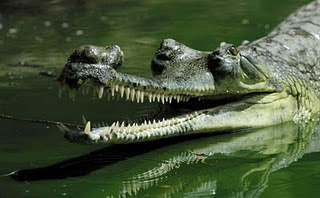 The Wildlife | Gharial | The Gharial is one of the largest crocodilian species. They are between 4 and 6 m (13 - 19.7 ft) in length and they can weigh up to 450 kgs (1,000 lbs). They have a life expectancy in the wild of 40 - 60 years. Gharial are large and slender with a distinctive narrow snout. The snout shape varies depending on the age of the animal - it becomes longer and thinner as they get older. Males have a bulbous growth, known as a ghara, on the end of their snout and this produces bubbles and sounds during courtship. They have extremely sharp teeth with there being 54 - 58 on their upper jaw and 50 - 52 on their lower jaw.
The Wildlife | Gharial | The Gharial is one of the largest crocodilian species. They are between 4 and 6 m (13 - 19.7 ft) in length and they can weigh up to 450 kgs (1,000 lbs). They have a life expectancy in the wild of 40 - 60 years. Gharial are large and slender with a distinctive narrow snout. The snout shape varies depending on the age of the animal - it becomes longer and thinner as they get older. Males have a bulbous growth, known as a ghara, on the end of their snout and this produces bubbles and sounds during courtship. They have extremely sharp teeth with there being 54 - 58 on their upper jaw and 50 - 52 on their lower jaw.  The gharial is a carnivorous animal and a dominant predator within its environment. The only time that this isn't the case is when the gharial share its territory with a large salt-water crocodile. Fish is the primary food of the gharial along with insects and occasionally small animals. Due to its large size, the gharial has no natural predators within its environment besides humans who hunt the gharial, often for leather or meat. The gharial has also been devastatingly affected by the increasingly levels of pollution in the water and is today considered to be critically endangered in the wild.
The gharial is a carnivorous animal and a dominant predator within its environment. The only time that this isn't the case is when the gharial share its territory with a large salt-water crocodile. Fish is the primary food of the gharial along with insects and occasionally small animals. Due to its large size, the gharial has no natural predators within its environment besides humans who hunt the gharial, often for leather or meat. The gharial has also been devastatingly affected by the increasingly levels of pollution in the water and is today considered to be critically endangered in the wild.Gharial are found in the slow moving backwaters of large rivers in the northern Indian subcontinent. They spend most of their time in the water, only leaving it to bask in the sun or to lay eggs. Gharials feed almost exclusively on fish although occasionally they will feed on water birds or carrion. Young Gharials will eat insects, larvae and small frogs.
Gharial
Gharial
Gharial
Gharial





0 comments:
Post a Comment